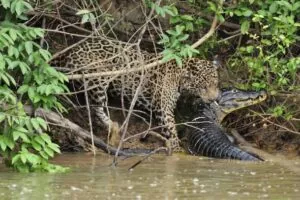The Atacama Desert at San Pedro
The Atacama Desert at San Pedro
Travelers are mesmerized by the stark beauty of the ridiculously-arid, 1,600-kilometer-long Atacama Desert of northern Chile, which is one of the three most popular tourist destinations in Chile and Latin America. It is, in fact, the driest nonpolar region on Earth, with most locations there experiencing less than 15 mm (0.6 inches) of rain per year. Many locations have an average of 1-3 mm of rain per year and some weather stations in the Atacama have never recorded any rain at all.
The lack of rain means that no plants grow and thus the raw geology of the Andes is on full, colorful display, with all manners of earth tones and pastels painting a mixture of flat plains and rugged geology that easily could pass for the surface of the Moon. Tests for life in the dry soils of Atacama in fact turned up nothing at all, much like the results of the search for life on Mars.
To be able to experience such a geological and scenic extreme with comfort is the brilliant concept of Atacama, as the attractive desert oasis of San Pedro de Atacama offers a number of very stylish, even luxurious hotels. It is a short drive from these hotels to the bizarre Atacama Salt Flats, where the crinkled white plain of salt is punctuated by shallow, hyper-saline lakes complete with small flocks of Andean Flamingos. With a global population of only 40,000 birds, this majestic wading bird is the rarest of the world’s six species of flamingoes.
We recommend a stay of 2-3 days in San Pedro to soak up the best of the desert scenery followed by an additional 3-4 days of exploration by 4WD of the highlands of SW Bolivia to see blood-red, green, and blue salt and alkaline lakes replete with two additional species of flamingoes, one more beautiful than the next. In extreme SW Bolivia, the most bizarre of all these high-elevation lakes is Laguna Colorada, an 8-kilometer-by-10-kilometer, extremely-alkaline lake that is only one foot deep. This caustic, other-worldly lake is the only known breeding site of the second-rarest flamingo in the world, the delicate James Flamingo, which has a global population of only 50,000. The bare, light-orange volcanoes visible from the lake, the reddish-orange terrain all around the lake, and the lake’s pure-white islands of loose borax being drawn up into the air by dust-devils all make this location look more like Mars than Mars itself.
The third species of flamingo visible in the high lakes of SW Bolivia is the Chilean Flamingo. To be able to observe three flamingo species in one day is unique to these lakes of SW Bolivia. It is hard to decide which of the three is the most beautiful, but probably the answer is “the one you are looking at the moment”.







